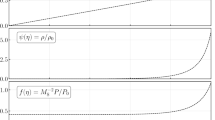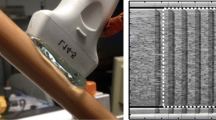Abstract
In the present work, high-speed visualizations at one million frames/s have been used to study the oscillation characteristics of acoustic cavitation bubbles. The bubbles are generated by acoustic cavitation using an ultrasound transducer with an excitation frequency of 75 kHz near a rigid surface and the medium used is deionized water. The cavitation bubbles tend to collect in clusters near solid boundaries, where they are visualized using a high-speed camera. The collective oscillations give rise to many interesting phenomena like bubble collapse, coalescence, fragmentation and bubble translation. The image sequences provided here contribute to the better understanding of the entire lifecycle of acoustic cavitation bubbles.
Graphical abstract












Similar content being viewed by others
References
Apfel RE (1997) Sonic effervescence: a tutorial on acoustic cavitation. J Acoust Soc Am 101:1227–1237
Arora M, Junge L, Ohl CD (2005) Cavitation cluster dynamics in shock-wave lithotripsy: part 1. Free field. Ultrasound Med Biol 31:827–839
Benjamin TB, Ellis aT (1966) The collapse of cavitation bubbles and the pressures thereby produced against solid boundaries. Philos Trans A Math Phys Eng Sci 260:221–240
Birkin PR, Offin DG, Vian CJB, Leighton TG (2011) Multiple observations of cavitation cluster dynamics close to an ultrasonic horn tip. J Acoust Soc Am 130:3379–3388
Bjerknes V (1906) Fields of force. Columbia University Press, New York
Bremond N, Arora M, Ohl CD, Lohse D (2006) Controlled multibubble surface cavitation. Phys Rev Lett 96(224):501
Brujan EA, Ikeda T, Yoshinaka K, Matsumoto Y (2011) The final stage of the collapse of a cloud of bubbles close to a rigid boundary. Ultrason Sonochem 18:59–64
Chivate MM, Pandit AB (1995) Quantification of cavitation intensity in fluid bulk. Ultrason Sonochem 2:S19–S25
Crum LA (1975) Bjerknes forces on bubbles in a stationary sound field. J Acoust Soc Am 57:1363–1370
Crum LA (1980) Measurements of the growth of air bubbles by rectified diffusion. J Acoust Soc Am 68:203–211
Crum LA (1984) Acoustic cavitation series: part five rectified diffusion. Ultrasonics 22:215–223
Duda RO, Hart PE (1972) Use of the Hough transformation to detect lines and curves in pictures. Commun ACM 15:11–15
Eller A, Flynn HG (1969) Generation of subharmonics of order one half by bubbles in a sound field. J Acoust Soc Am 46:722–727
Esche R (1952) Untersuchung der Schwingungskavitation in Flüssigkeiten. Akust Beihefte 2:208–218
Hansson I, Mørch KA (1980) The dynamics of cavity clusters in ultrasonic (vibratory) cavitation erosion. J Appl Phys 51:4651–4658
Hansson I, Kedrinskii V, Mørch KA (1982) On the dynamics of cavity clusters. J Phys D Appl Phys 15:1725–1734
Hough PVC (1962) Method and means for recognizing complex patterns. US Patent 3,069,654
Illingworth J, Kittler J (1988) A survey of the hough transform. Comput Vision Graph 44:87–116
Kornfeld M, Suvorov L (1944) On the destructive action of cavitation. J Appl Phys 15:495–506
Krefting D, Mettin R, Lauterborn W (2004) High-speed observation of acoustic cavitation erosion in multibubble systems. Ultrason Sonochem 11:119–123
Lauterborn W (1969) On a theory of cavitation thresholds. Acta Acust United Acust 22:48–54
Lauterborn W (1970) Resonance curves of gas bubbles in liquids. Acta Acust United Acust 23:73–81
Lauterborn W, Bolle H (1975) Experimental investigations of cavitation-bubble collapse in the neighbourhood of a solid boundary. J Fluid Mech 72:391–399
Lauterborn W, Cramer E (1981) Subharmonic route to chaos observed in acoustics. Phys Rev Lett 47:1445–1448
Leighton T (1994) The acoustic bubble. Oxford University Press, New York
Leighton T (1995) Bubble population phenomena in acoustic cavitation. Ultrason Sonochem 2:S123–S136
Mettin R (2007) From a single bubble to bubble structures in acoustic cavitation. In: Kurz T, Parlitz U, Kaatze U (eds) Oscillations. Waves and Interactions, Universitätsverlag Göttingen, Göttingen, pp 171–198
Mettin R, Akhatov I, Parlitz U, Ohl CD, Lauterborn W (1997) Bjerknes forces between small cavitation bubbles in a strong acoustic field. Phys Rev E Stat Phys Plasmas Fluids Relat Interdiscip Top 56:2924–2931
Minnaert M (1933) XVI. On musical air-bubbles and the sounds of running water. Philos Mag Ser 7 16:235–248
Neppiras EA (1969) Subharmonic and other low frequency emission from bubbles in sound-irradiated liquids. J Acoust Soc Am 46:587–601
Neppiras EA (1980) Acoustic cavitation thresholds and cyclic processes. Ultrasonics 18:201–209
Neppiras EA, Fill EE (1969) A cyclic cavitation process. J Acoust Soc Am 46:1264–1271
Olson HG, Hammitt FG (1969) High-speed photographic studies of ultrasonically induced cavitation. J Acoust Soc Am 46:1272–1283
Parlitz U, Mettin R, Luther S, Akhatov I, Voss M, Lauterborn W (1999) Spatio-temporal dynamics of acoustic cavitation bubble clouds. Philos Trans R Soc A Math Phys Eng Sci 357:313–334
Peng T (2005) Detect circles with various radii in grayscale image via Hough transform. http://www.mathworks.de/matlabcentral/fileexchange/9168-detect-circles-with-various-radii-in-grayscale-image-via-hough-transform
Prosperetti A (1975) Nonlinear oscillations of gas bubbles in liquids. Transient solutions and the connection between subharmonic signal and cavitation. J Acoust Soc Am 57:810–821
Rayleigh L (1917) VIII. On the pressure developed in a liquid during the collapse of a spherical cavity. Philos Mag Ser 6 34:94–98
Sato M, Shibuya N, Okada N, Tou T, Fujii T (2002) Oscillation mode conversion and energy confinement of acoustically agitated bubbles. Phys Rev E 65(46):302
Smith FD (1935) XCVIII. On the destructive mechanical effects of the gas-bubbles liberated by the passage of intense sound through a liquid. Philos Mag Ser 7 19:1147–1151
Smith RH, Mesler RB (1972) A photographic study of the effect of an air bubble on the growth and collapse of a vapor bubble near a surface. J Basic Eng 94:933–940
Tervo JT, Mettin R, Lauterborn W (2006) Bubble cluster dynamics in acoustic cavitation. Acta Acust United Acust 92:178–180
Vian CJB, Birkin PR, Leighton TG (2010) Cluster collapse in a cylindrical cell: correlating multibubble sonoluminescence, acoustic pressure, and erosion. J Phys Chem C 114:16416–16425
Zervacic Z, Lohse D, Van Saarloos W (2010) Collective oscillations in bubble clouds. J Fluid Mech 680(16):114–149
Acknowledgments
The authors gratefully acknowledge funding of the Erlangen Graduate School in Advanced Optical Technologies (SAOT) by the German Research Foundation (DFG) in the framework of the German excellence initiative. We also thank the Bayerische Forschungsstiftung (BFS) for the financial support.
Author information
Authors and Affiliations
Corresponding author
Electronic supplementary material
Below is the link to the electronic supplementary material.
Rights and permissions
About this article
Cite this article
Vaidya, H.A., Ertunç, Ö., Lichtenegger, T. et al. High-speed visualization of acoustically excited cavitation bubbles in a cluster near a rigid boundary. J Vis 20, 359–368 (2017). https://doi.org/10.1007/s12650-015-0280-3
Received:
Revised:
Accepted:
Published:
Issue Date:
DOI: https://doi.org/10.1007/s12650-015-0280-3




